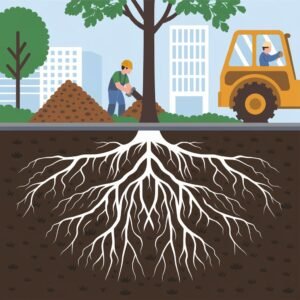Ensuring tree health amidst urban challenges
Tree roots are the foundation of a tree’s health, yet they face significant challenges in urban settings. Compact soils, limited space, and infrastructure development often hinder their natural growth and function. Adopting the right practices not only preserves trees but also enhances urban landscapes. This blog explores actionable strategies to maintain healthy root environments in cities and towns.
Why Do Tree Roots Struggle in Urban Areas?
The hidden challenges beneath the surface
Urban environments create unique obstacles for tree roots. Factors like soil compaction from foot traffic and vehicles, restricted root zones near sidewalks and buildings, and inadequate drainage can lead to stunted growth and weakened stability. Without proper management, these issues can result in declining tree health or even hazardous conditions.
Top Practices for Managing Urban Tree Roots
1. Mulching: The Simplest Way to Protect Roots
Enhance soil health and reduce compaction
Applying organic mulch around the base of trees creates a protective layer that mimics natural forest floors. Mulch improves moisture retention, suppresses weeds, and encourages beneficial soil organisms. Use wood chips, bark, or leaf mould to cover as much of the root zone as possible, keeping mulch at least a few centimetres away from the trunk to prevent decay.
2. Soil Aeration and Decompaction
Break through compacted soils for healthier roots
Urban soils often suffer from compaction, reducing oxygen and water availability. Aeration techniques, like soil augers or air spades, loosen compacted areas without damaging roots. For long-term improvement, consider decompaction methods combined with organic mulching to restore root access to vital nutrients and water.
3. Root-Friendly Construction Practices
Minimise root damage during urban projects
Tree roots are often inadvertently damaged during infrastructure development. Before construction, consult with an arboriculturist to assess root zones and plan protective measures, such as root barriers or adjusted excavation methods. Following BS 5837 standards ensures minimal disruption to root systems.
4. Strategic Irrigation
Support roots with smart water management
Urban trees often compete for water in limited soil. Irrigate deeply but infrequently to encourage deep root growth. Drip irrigation systems are effective for targeting the root zone without wasting water. Avoid overwatering, which can lead to waterlogged soils and root rot.
5. Fertilisation and Soil Health
Address nutrient deficiencies carefully
Conduct soil testing before applying fertilisers to determine specific deficiencies. Organic options like compost or bone meal can provide sustained nutrient release without harming roots. Avoid excessive use of chemical fertilisers, as they can disrupt soil microbiomes.
Challenges of Managing Tree Roots in Cities
1. Space Constraints
Roots need room to spread and anchor trees effectively. Limited space near pavements, buildings, and roads can restrict growth. To address this, use structural soils or suspended pavements that allow root expansion without damaging infrastructure.
2. Urban Heat Islands
High temperatures in cities dry out soils faster, stressing roots. Mulching and adequate irrigation combat these effects, keeping root zones cool and moist.
3. Damage from Human Activity
Foot traffic, parked vehicles, and construction equipment can compact soils and injure roots. Designating root protection zones with barriers or fencing can prevent accidental damage.

Tree Roots | Tiptop Tree Services
FAQs About Urban Tree Root Management
- Why is soil aeration important for tree roots?
Aeration restores oxygen flow to compacted soils, helping roots grow deeper and absorb nutrients effectively. - How much mulch should I apply around urban trees?
Apply 5–10 cm of organic mulch across the root zone but avoid piling it against the tree trunk. - Can damaged roots recover?
With proper care, such as mulching, irrigation, and reduced stress, roots can often recover and support tree health. - Are root barriers harmful to trees?
When installed correctly, root barriers protect infrastructure while directing roots into safe areas for growth. - What is the best way to water urban trees?
Use deep watering techniques, such as drip irrigation, to encourage deep root growth and avoid shallow, surface-level roots.
Safeguard Your Urban Trees Today
Struggling with compacted soils or exposed roots? Let us help you manage your trees with professional care and expert solutions.
Call us for a free tree assessment: 07392001837
Visit our website: https://tiptoptreeandgroundcare.co.uk
Our location
Keep your trees thriving and your property safe with Tip Top Tree Services!

